Symbolic Regression for the Determination of Joint Roughness Coefficient
Abstract
1. Introduction
2. Review of the JRC Empirical Equation
3. Materials and Methods
3.1. Symbolic Regression
- Step 1: Determine the maximum cycles, population size, probability of crossover and mutation, etc.
- Step 2: Set the mathematical expression space for symbolic regression.
- Step 3: Generate the initialized population for genetic programming randomly.
- Step 4: Evaluate each individual in the population and determine their fitness value.
- Step 5: Generate the new population based on the genetic operator, such as selection, crossover, or mutation.
- Step 6: Meet the stop criterion and obtain and output the final JRC equation. Otherwise, repeat steps 4 and 5.
3.2. The JRC Presentation Based on Symbolic Regression
3.3. Procedure of Symbolic Regression-Based JRC Empirical Equation
- Step 1: Collect the rock joint samples, determine JRC by test, and compute the statistical parameters.
- Step 2: Construct the training samples based on the JRC and the corresponding statistical parameters of the rock joint.
- Step 3: Select and set the parameters and operator of the symbolic regression algorithm.
- Step 4: Call the symbolic regression algorithm based on the abovementioned training samples.
- Step 5: Generate the empirical equation based on the symbolic regression.
- Step 6: Estimate the JRC value for the new unknown rock joint based on the generated empirical equation.
4. Results
4.1. Dataset of the Rock Joint
4.2. Determination of JRC Using Symbolic Regression
5. Discussion
5.1. The Relationship Between JRC and the Statistical Parameters of the Rock Joint
5.2. Sensitivity Analysis
5.3. Feature Analysis of Symbolic Regression Model for JRC
6. Conclusions
- (1)
- It is challenging to capture the complex relationship between the joint roughness coefficient and the statistical parameters of rock joints. This study developed an empirical equation for JRC determination based on rock joint data and symbolic regression. The developed empirical equation can estimate the JRC value and provides an excellent scientific tool to quantify the JRC for rock joints.
- (2)
- Generalization performance is essential to the machine learning model. The symbolic regression-based JRC empirical equation has an excellent generalization performance. Moreover, the developed empirical equation considers the interaction of the rock joint statistical parameters and fully captures the complex and nonlinear relation of the JRC and the statistical parameters of the rock joint. It is feasible to predict the JRC value using the developed model and the statistical parameters of rock joints.
- (3)
- Symbolic regression is a data-driven machine learning technique with excellent interpretable performance. Symbolic regression not only characterizes the roughness property of rock joints but also captures the contribution of each statistical parameter to the JRC value. Symbolic regression provides a scientific and excellent tool for characterizing the roughness property of rock joints. Furthermore, it is helpful for other complex problems of rock mechanics.
- (4)
- The dataset size is essential to the developed JRC empirical equation, and the current study proves its feasibility. As rock engineering data accumulates, the obtained empirical equation will be enhanced and improved further. Meanwhile, future studies will further investigate the rock joint property, strength mechanism, and the associated uncertainty based on the empirical equation developed.
- (5)
- Data are the core and are essential to the developed method. The method’s performance depends on the quality and quantity of the dataset. The proposed method will be further developed and improved with the accumulation of data and the development of the JRC theory.
Author Contributions
Funding
Data Availability Statement
Conflicts of Interest
References
- Barton, N. Review of a new shear-strength criterion for rock joints. Eng. Geol. 1973, 7, 287–332. [Google Scholar] [CrossRef]
- Barton, N.; Choubey, V. The shear strength of rock joints in theory and practice. Rock Mech. 1977, 10, 1–54. [Google Scholar] [CrossRef]
- Brown, E.T. Rock Characterization Testing and Monitoring (ISRM Suggested Methods); Pergamon Press: Oxford, UK, 1981. [Google Scholar]
- Kulatilake, P.H.S.W.; Ankah, M.L.Y. Rock Joint Roughness Measurement and Quantification—A Review of the Current Status. Geotechnics 2023, 3, 116–141. [Google Scholar] [CrossRef]
- Ge, Y.; Kulatilake, P.H.S.W.; Tang, H.; Xiong, C. Investigation of natural rock joint roughness. Comput. Geotech. 2014, 55, 290–305. [Google Scholar] [CrossRef]
- Tse, R.; Cruden, D.M. Estimating joint roughness coefficients. Int. J. Rock. Mech. Min. Sci. Geomech. Abstr. 1979, 16, 303–309. [Google Scholar] [CrossRef]
- Wang, Q. Study on Determination of Rock Joint Roughness by Using Elongation Rate R; China Civil Engineering Society: Beijing, China, 1982; pp. 343–348. [Google Scholar]
- El-Soudani, S.M. Profilometric analysis of fractures. Metallography 1978, 11, 247–336. [Google Scholar] [CrossRef]
- Maerz, N.H.; Franklin, J.A.; Bennett, C.P. Joint roughness measurement using shadow profilometry. Int. J. Rock. Mech. Min. Sci. Geomech. Abstr. 1990, 27, 329–343. [Google Scholar] [CrossRef]
- Yu, X.B.; Vayssade, B. Joint profiles and their roughness parameters. Int. J. Rock. Mech. Min. Sci. Geomech. Abstr. 1991, 28, 333–338. [Google Scholar] [CrossRef]
- Barton, N.; de Quadros, E.F. Joint aperture and roughness in the prediction of flow and groutability of rock masses. Int. J. Rock. Mech. Min. Sci. 1997, 34, 3–4. [Google Scholar] [CrossRef]
- Yang, Z.Y.; Lo, S.C.; Di, C.C. Reassessing the joint roughness coefficient (JRC) estimation using Z2. Rock Mech. Rock Eng. 2001, 34, 243–251. [Google Scholar] [CrossRef]
- Li, Y.; Zhang, Y. Quantitative estimation of joint roughness coefficient using statistical parameters. Int. J. Rock. Mech. Min. Sci. 2015, 77, 27–35. [Google Scholar] [CrossRef]
- Grasselli, G. Shear Strength of Rock Joints Based on Quantified Surface Description; Swiss Federal Institute of Technology (EPFL): Lausanne, Switzerland, 2001. [Google Scholar]
- Gao, Y.; Wong, L.N.Y. A modified correlation between roughness parameter Z2 and the JRC. Rock Mech. Rock. Eng. 2013, 48, 387–396. [Google Scholar] [CrossRef]
- Li, H.; Huang, R.Q. Method of quantitative determination of joint roughness coefficient. Chin. J. Rock. Mech. Eng. 2014, 33, 3489–3497. [Google Scholar]
- Li, Y.; Huang, R. Relationship between joint roughness coefficient and fractal dimension of rock fracture surfaces. Int. J. Rock. Mech. Min. Sciences. 2015, 75, 15–22. [Google Scholar] [CrossRef]
- Kulatilake, P.; Balasingam, P.; Park, J.; Morgan, R. Natural rock joint roughness quantification through fractal techniques. Geotech. Geol. Eng. 2006, 24, 1181–1201. [Google Scholar] [CrossRef]
- Huang, S.L.; Oelfke, S.M.; Speck, R.C. Applicability of fractal characterization and modelling to rock joint profiles. Int. J. Rock. Mech. Min. Sci. 1992, 29, 135–153. [Google Scholar] [CrossRef]
- Lee, Y.H.; Carr, J.R.; Bars, D.J.; Hass, C.J. The fractal dimension as a measure of the roughness of rock discontinuity profiles. Int. J. Rock. Mech. Min. Sci. 1990, 27, 453–464. [Google Scholar] [CrossRef]
- Xie, H.P.; Pariseau, W.G. Fractal estimation of rock joint roughness coefficient. Sci. China 1994, 24, 524–530. [Google Scholar]
- Askari, M.; Ahmadi, M. Failure process after peak strength of artificial joints by fractal dimension. Geotech. Geol. Eng. 2007, 25, 631–637. [Google Scholar] [CrossRef]
- Deng, J.; Gu, D.; Li, X.; Yue, Z.Q. Structural reliability analysis for implicit performance functions using artificial neural network. Struct. Safe 2005, 27, 25–48. [Google Scholar] [CrossRef]
- Ren, J.; Zhao, H.; Zhang, L.; Zhao, Z.; Xu, Y.; Cheng, Y.; Wang, M.; Chen, J.; Wang, J. Design optimization of cement grouting material based on adaptive Boosting algorithm and simplicial homology global optimization. J. Build. Eng. 2022, 49, 104049. [Google Scholar] [CrossRef]
- He, M.; Zhang, L. Machine learning and symbolic regression investigation on stability of MXene materials. Comput. Mater. Sci. 2021, 196, 110578. [Google Scholar] [CrossRef]
- Zhao, H. Slope reliability analysis using a support vector machine. Comput. Geoteh. 2008, 35, 459–467. [Google Scholar] [CrossRef]
- Zhao, H.; Yin, S.; Ru, Z. Relevance vector machine applied to slope stability analysis. Int. J. Numer. Anal. Method. Geomech. 2012, 36, 643–652. [Google Scholar] [CrossRef]
- Yin, H.; Tang, Z.; Yang, C. Predicting hourly electricity consumption of chillers in subway stations: A comparison of support vector machine and different artificial neural networks. J. Build. Eng. 2023, 76, 107179. [Google Scholar] [CrossRef]
- Wang, L.; Xie, D.; Zhou, L.; Zhang, Z. Application of the hybrid neural network model for energy consumption prediction of office buildings. J. Build. Eng. 2023, 72, 106503. [Google Scholar] [CrossRef]
- Zhao, H.; Li, S.; Zang, X.; Liu, X.; Zhang, L.; Ren, J. Uncertainty quantification of inverse analysis for geomaterials using probabilistic programming. J. Rock. Mech. Geotech. Eng. 2024, 16, 895–908. [Google Scholar] [CrossRef]
- Ge, Y.; Cao, B.; Tang, H. Rock Discontinuities Identification from 3D Point Clouds Using Artificial Neural Network. Rock. Mech. Rock. Eng. 2022, 55, 1705–1720. [Google Scholar] [CrossRef]
- Wang, L.; Wang, C.; Khoshnevisan, S.; Ge, Y.; Sun, Z. Determination of two-dimensional joint roughness coefficient using support vector regression and factor analysis. Eng. Geol. 2017, 231, 238–251. [Google Scholar] [CrossRef]
- Fathipour-Azar, H. Data-driven estimation of joint roughness coefficient. J. Rock. Mech. Geotech. Eng. 2021, 13, 1428–1437. [Google Scholar] [CrossRef]
- Miao, F.; Wu, Y.; Li, L.; Liao, K.; Xue, Y. Prediction of joint roughness coefficient of rock mass based on boosting-decision tree C5.0. J. Zhejiang Univ. 2021, 55, 483–490. [Google Scholar]
- Zhang, H.; Wu, S.; Zhang, Z.; Han, L. Rock joint roughness determination method based on deep learning of time–frequency spectrogram. Eng. Appl. Artif. Intell. 2023, 117, 105505. [Google Scholar] [CrossRef]
- Asadzadeh, M.Z.; Gänser, H.P.; Mücke, M. Symbolic regression based hybrid semiparametric modelling of processes: An example case of a bending process. Appl. Eng. Sci. 2021, 6, 100049. [Google Scholar] [CrossRef]
- Jorge, M.G.; Jose, M.C.G. A novel method based on symbolic regression for interpretable semantic similarity measurement. Expert. Syst. Appl. 2021, 160, 113663. [Google Scholar]
- Schmidt, M.; Lipson, H. Distilling free-form natural laws from experimental data. Science 2009, 324, 81–85. [Google Scholar] [CrossRef]
- Bomarito, G.F.; Townsend, T.S.; Stewart, K.M.; Esham, K.V.; Emery, J.M.; Hochhalter, J.D. Development of interpretable, data-driven plasticity models with symbolic regression. Comput. Struct. 2021, 252, 106557. [Google Scholar] [CrossRef]
- Deshpande, N.; Londhe, S.; Kulkarni, S.S. Modelling Compressive Strength of Recycled Aggregate Concrete Using Neural Networks and Regression. Concr. Res. Lett. 2013, 4, 580–590. [Google Scholar]
- Sun, S.; Ouyang, R.; Zhang, B.; Zhang, T. Data-driven discovery of formulas by symbolic regression. MRS Bull. 2019, 44, 559–564. [Google Scholar] [CrossRef]
- Koza, J.R.; Keane, M.A.; Rice, J.P. Performance improvement of machine learning via automatic discovery of facilitating functions as applied to a problem of symbolic system identification. IEEE Int. Conf. Neural Netw. 1993, 1, 191–198. [Google Scholar]
- Wang, Y.; Wagner, N.; Rondinelli, J.M. Symbolic regression in materials science. MRS Commun. 2019, 9, 793–805. [Google Scholar] [CrossRef]
- Duan, Z.; Kang, J.; Li, J.; Zhao, X. Simulation for the thermal performance of super-hydrophilic fabric evaporative cooling roof based on experimental results. J. Build. Eng. 2022, 52, 104377. [Google Scholar] [CrossRef]
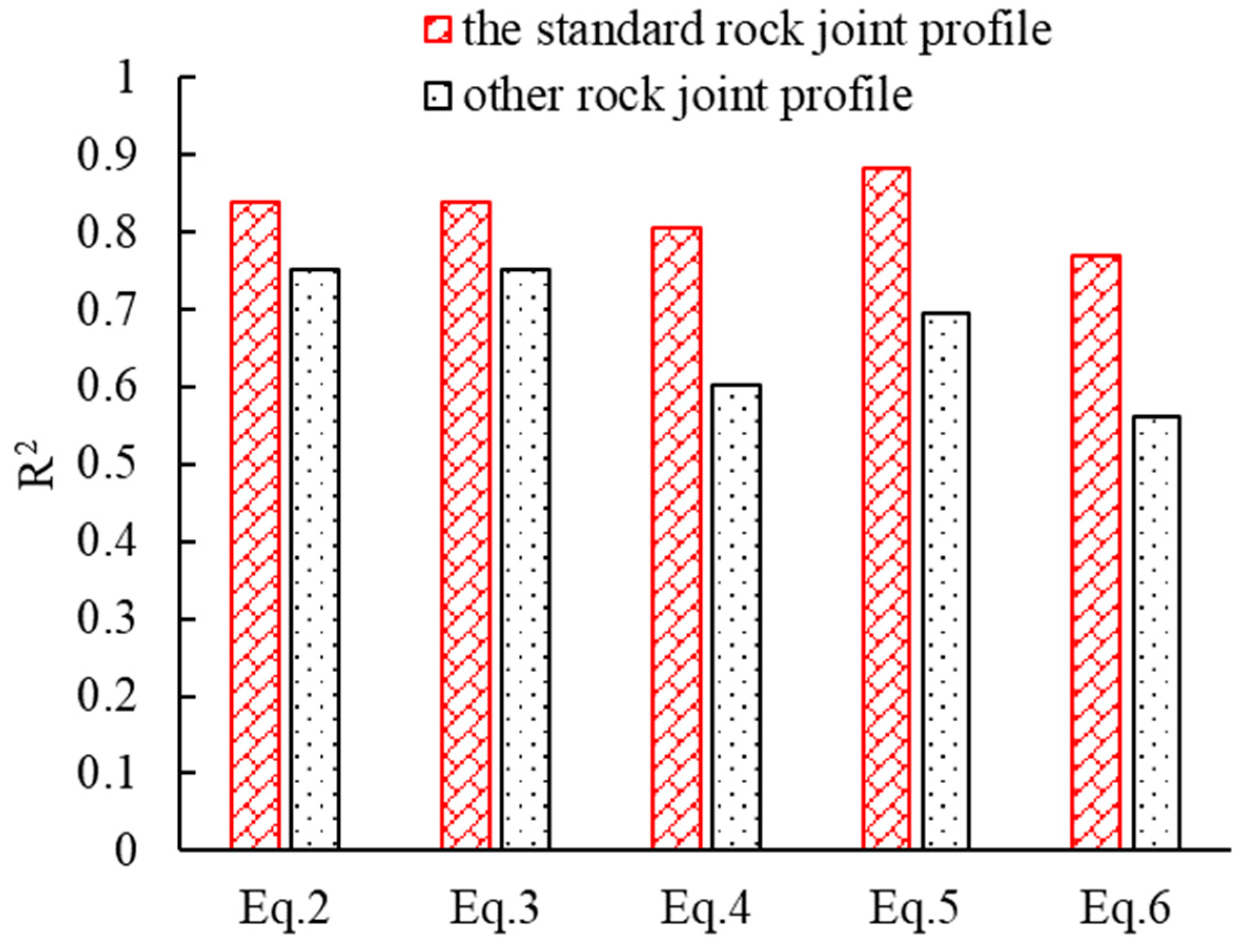
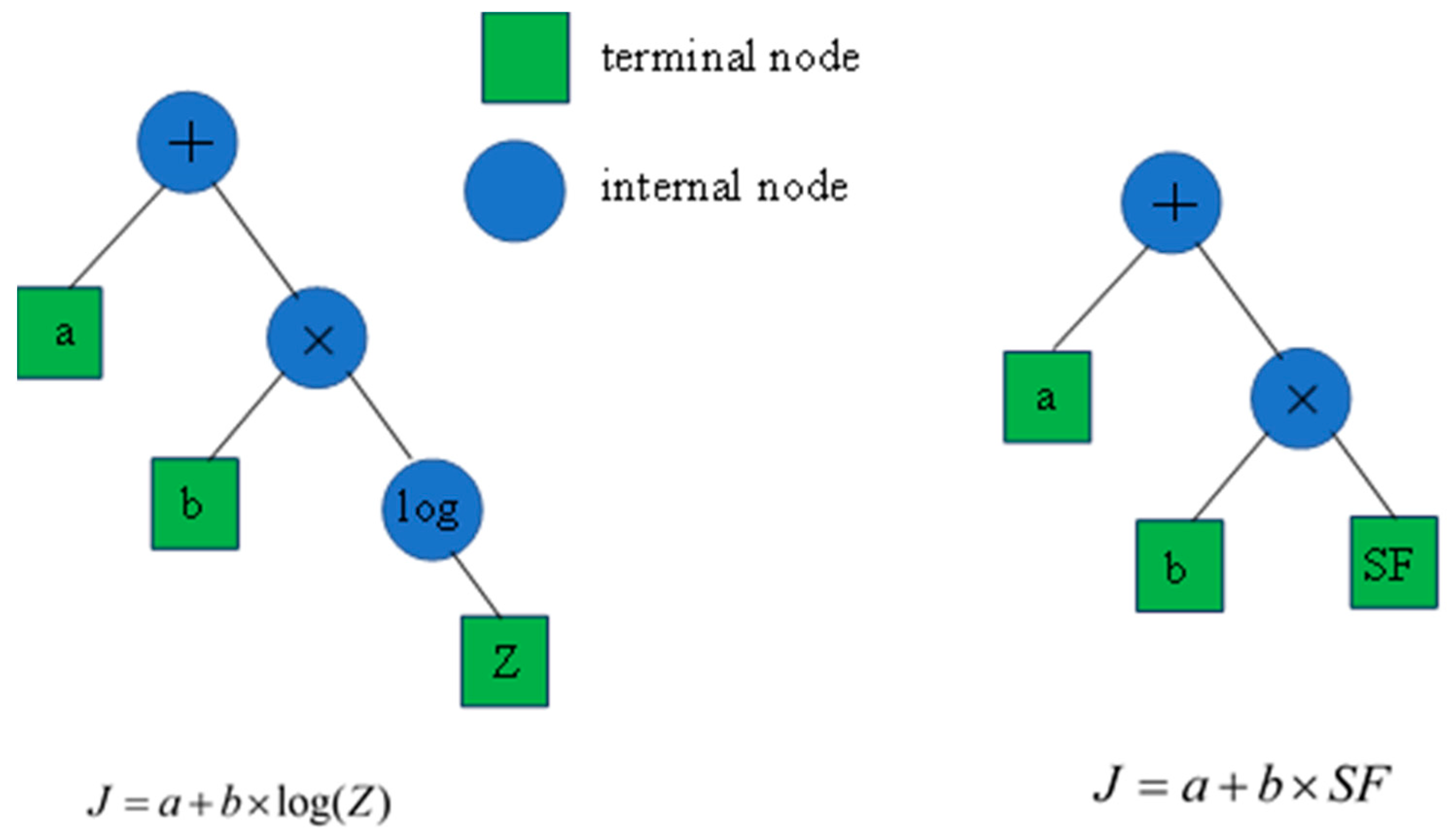


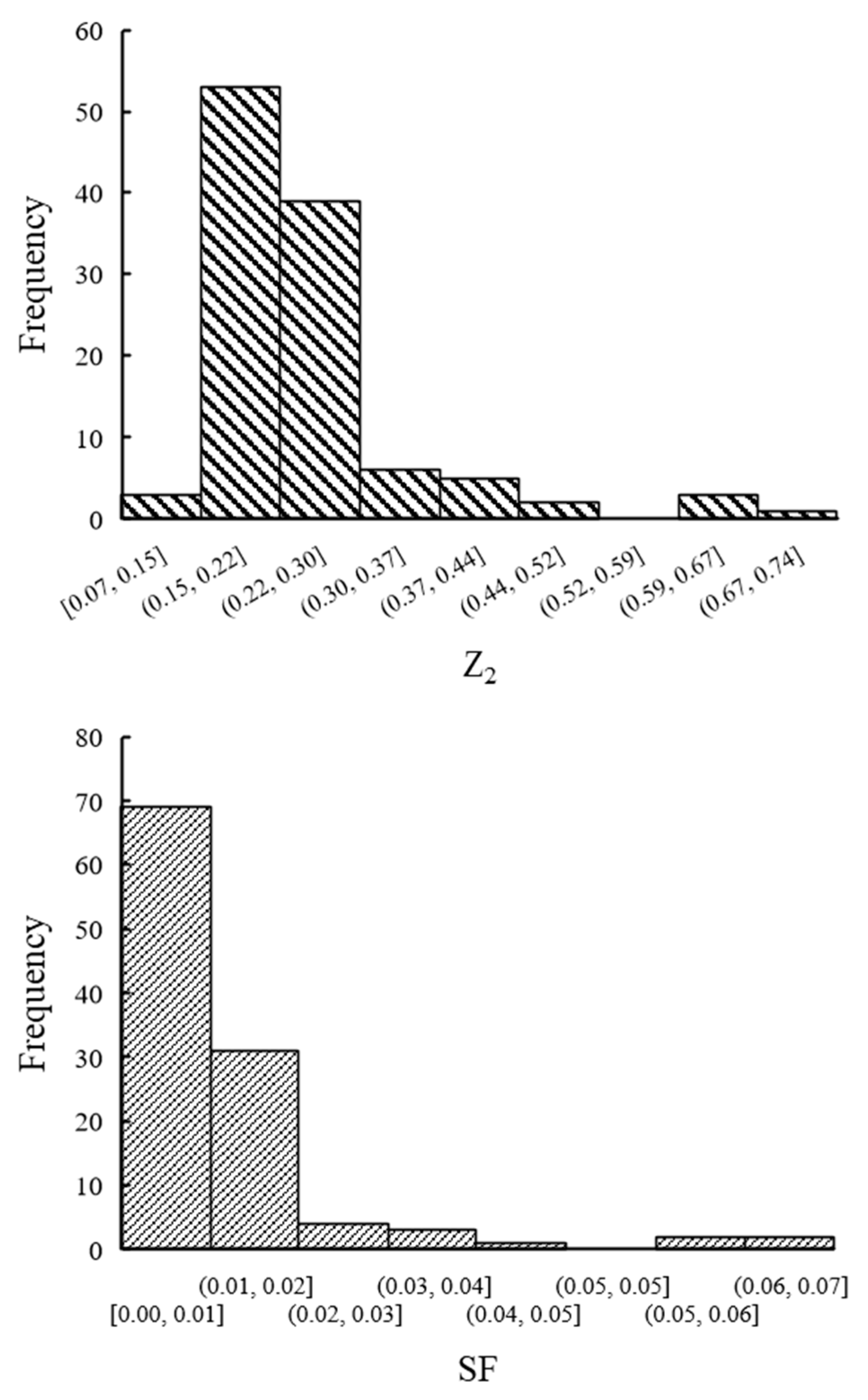
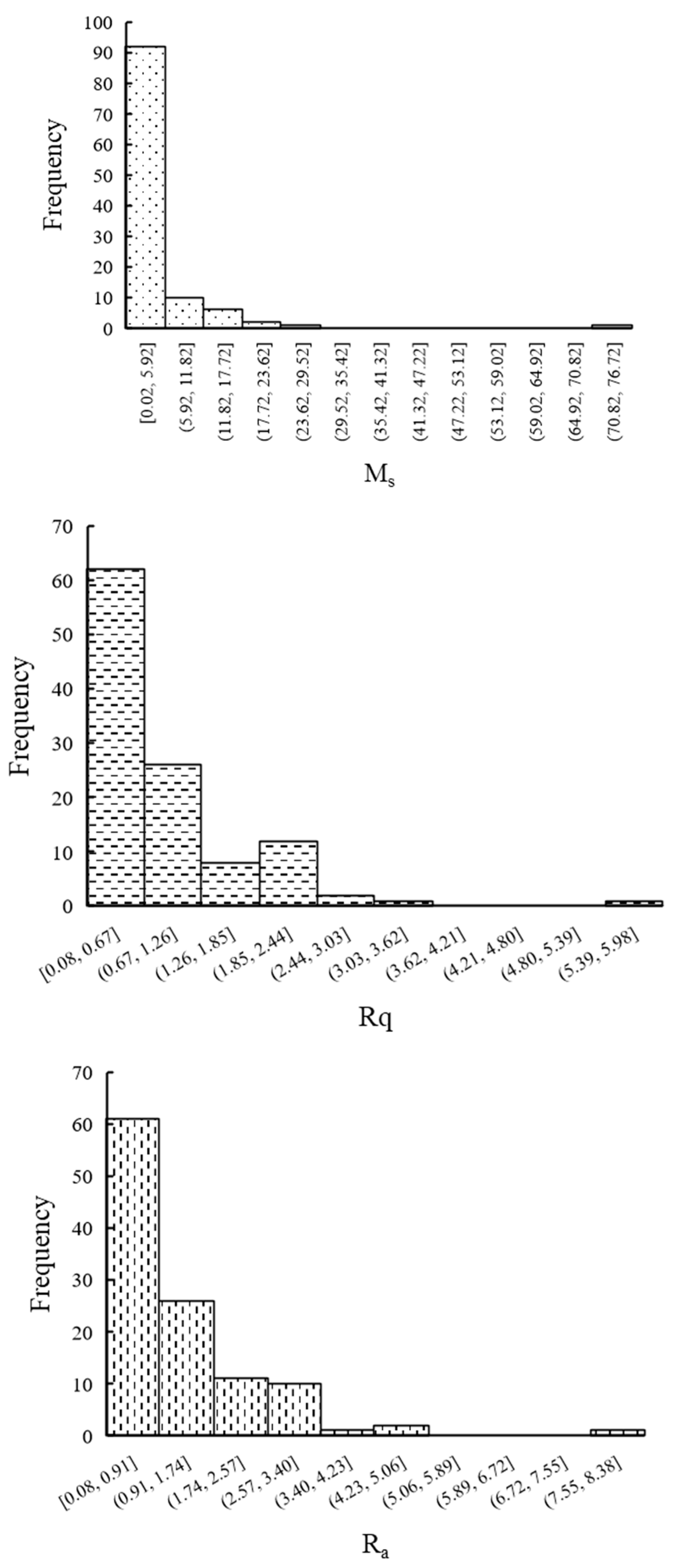
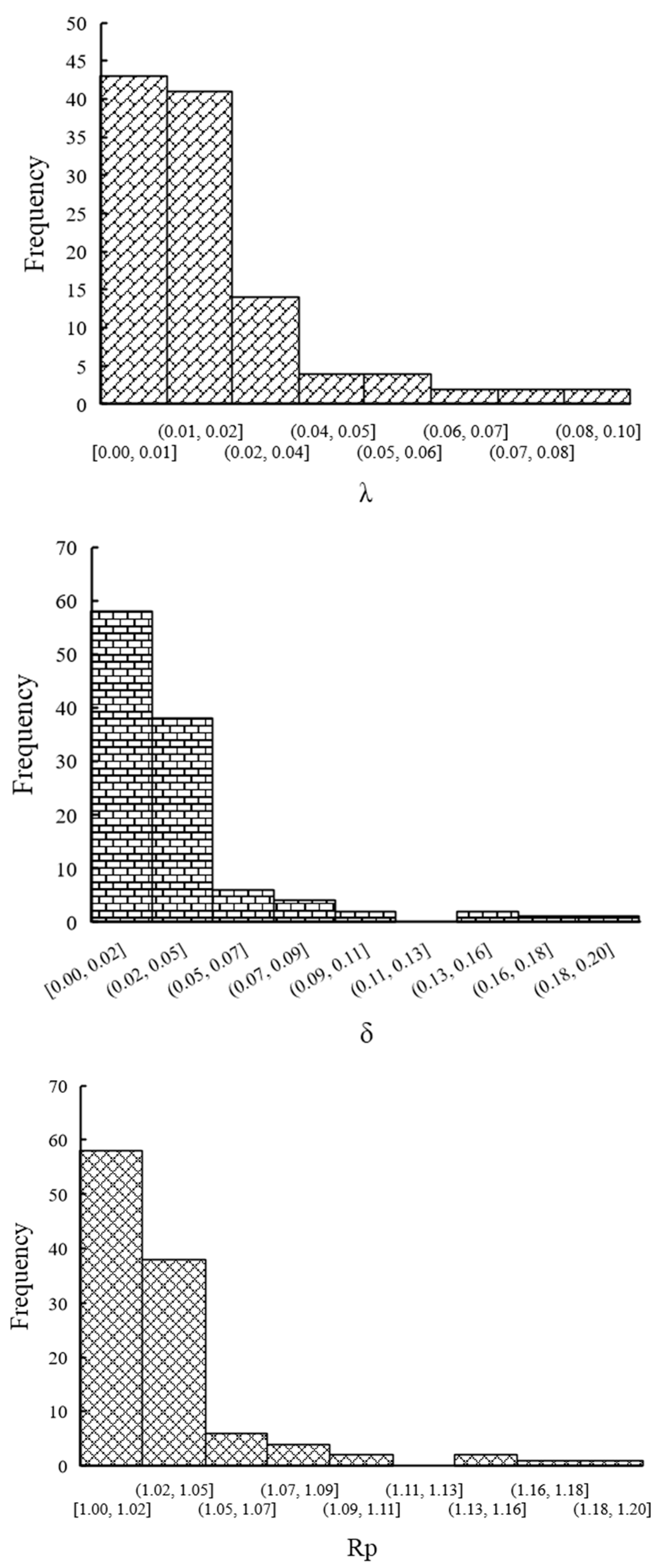
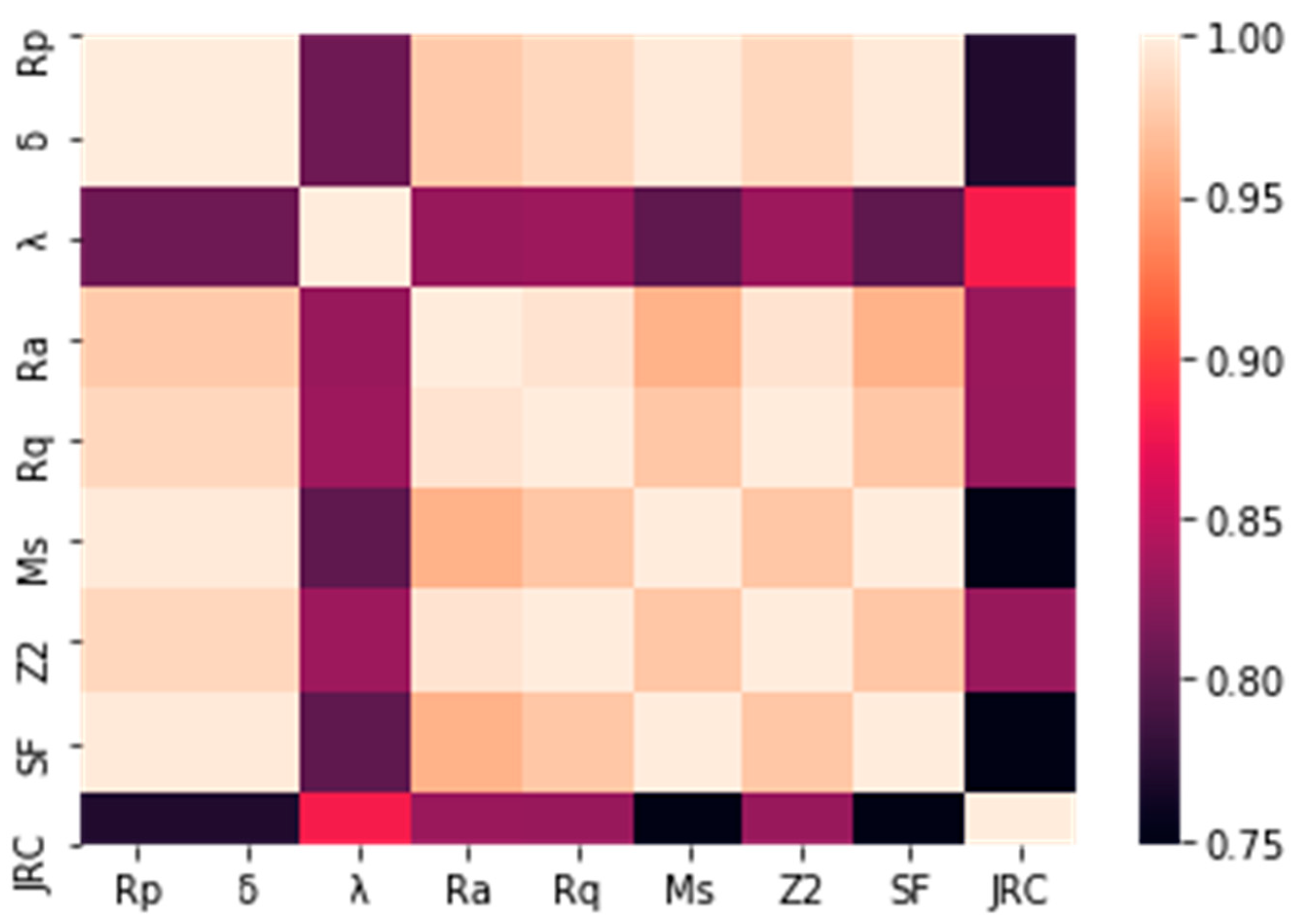


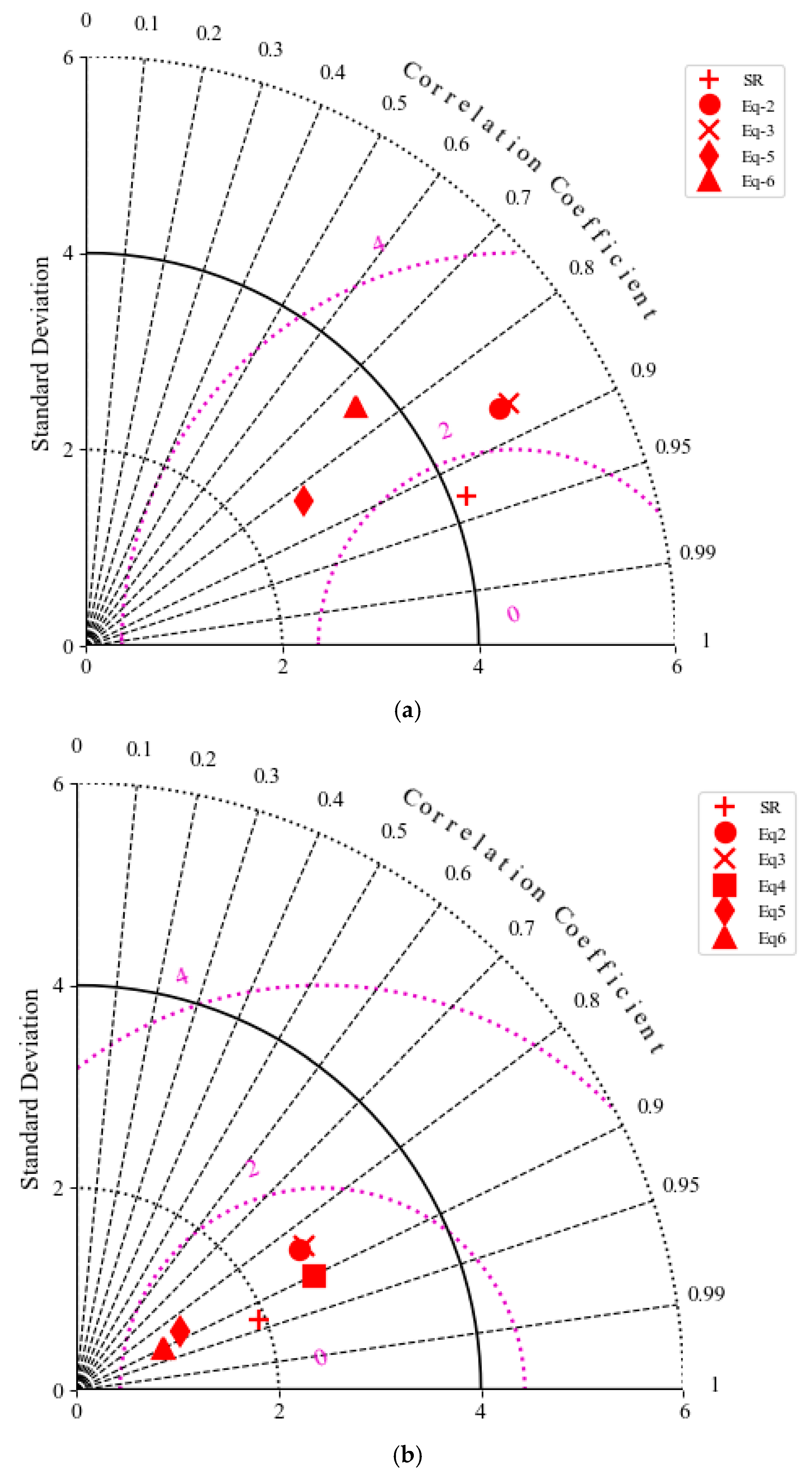



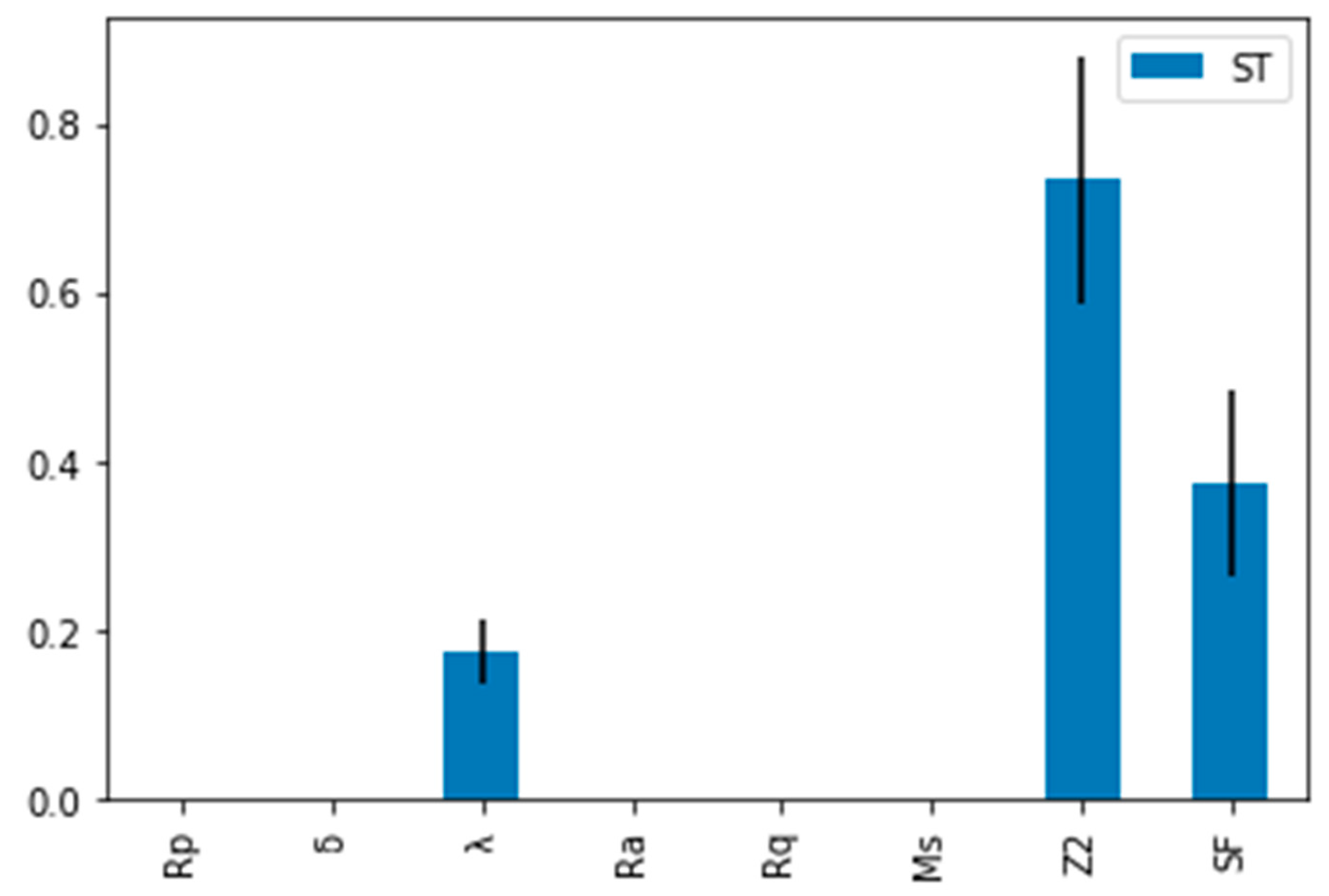

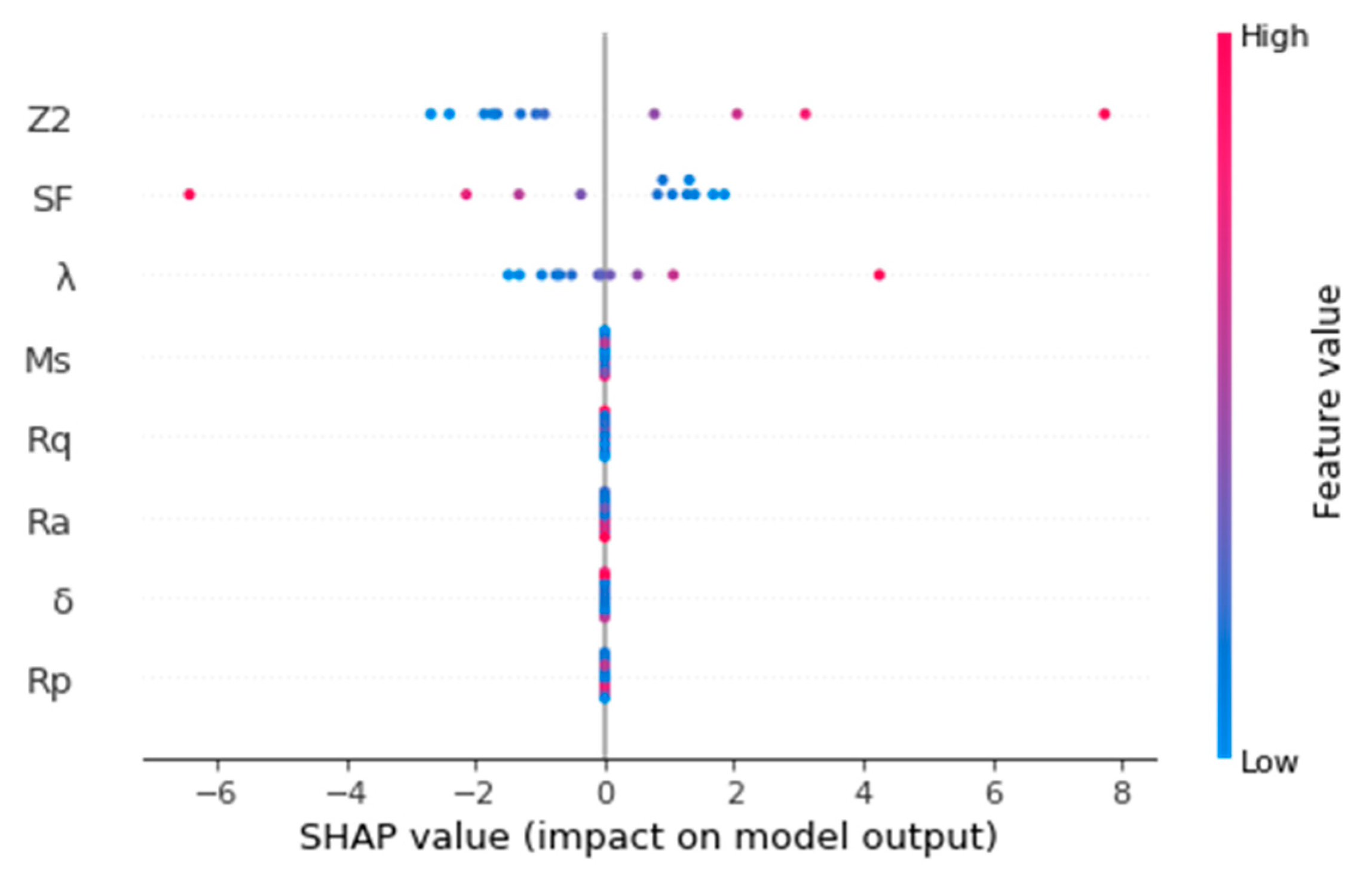
| Symbol | Definition |
|---|---|
| JRC | joint roughness coefficient |
| Z2 | first deviation of the profile |
| SF | structure–function |
| Ra | arithmetical mean deviation roughness index of the profile |
| Rq | root mean square roughness index of the profile |
| Ms | mean square value roughness index |
| Rp | roughness profile index |
| δ | profile elongation index |
| σi | standard deviation of the angle |
| λ | ultimate slope of profile |
Disclaimer/Publisher’s Note: The statements, opinions and data contained in all publications are solely those of the individual author(s) and contributor(s) and not of MDPI and/or the editor(s). MDPI and/or the editor(s) disclaim responsibility for any injury to people or property resulting from any ideas, methods, instructions or products referred to in the content. |
© 2025 by the authors. Licensee MDPI, Basel, Switzerland. This article is an open access article distributed under the terms and conditions of the Creative Commons Attribution (CC BY) license (https://creativecommons.org/licenses/by/4.0/).
Share and Cite
Zhao, Y.; Zhao, H. Symbolic Regression for the Determination of Joint Roughness Coefficient. Math. Comput. Appl. 2025, 30, 17. https://doi.org/10.3390/mca30010017
Zhao Y, Zhao H. Symbolic Regression for the Determination of Joint Roughness Coefficient. Mathematical and Computational Applications. 2025; 30(1):17. https://doi.org/10.3390/mca30010017
Chicago/Turabian StyleZhao, Yuyang, and Hongbo Zhao. 2025. "Symbolic Regression for the Determination of Joint Roughness Coefficient" Mathematical and Computational Applications 30, no. 1: 17. https://doi.org/10.3390/mca30010017
APA StyleZhao, Y., & Zhao, H. (2025). Symbolic Regression for the Determination of Joint Roughness Coefficient. Mathematical and Computational Applications, 30(1), 17. https://doi.org/10.3390/mca30010017





